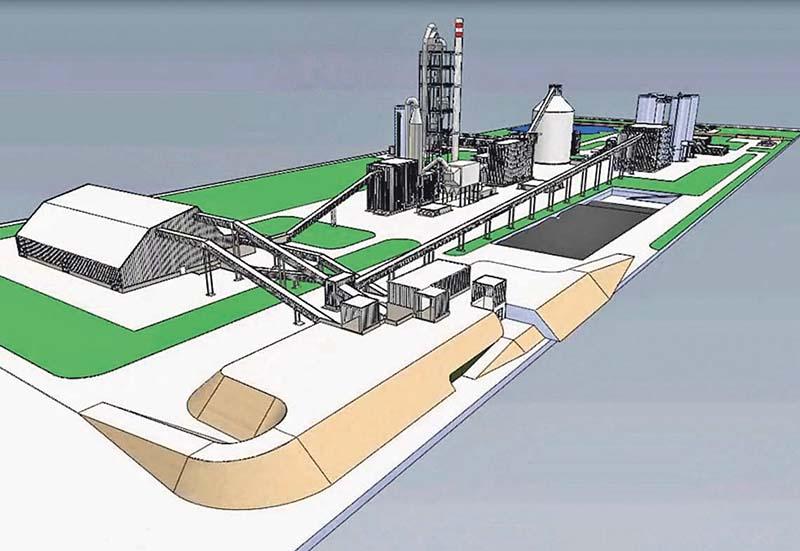Another week of the Local Planning Appeal Tribunal (LPAT) hearing into the proposed Colacem cement plant near L’Orignal has passed. The hearing is an appeal by Colacem of Champlain Township council’s 2017 rejection of a zoning by-law amendment required for the new plant, and it is also an appeal by Action Champlain of the United Counties of Prescott and Russell (UCPR) council’s approval in 2017 of an Official Plan Amendment required for the new plant.
The cement plant, if constructed, would be located next to the existing Colacem quarry on Highway 17, and would use limestone from that quarry.
On Friday, November 13, Ronald Caza, counsel representing Action Champlain, cross-examined Sean Capstick of Golder Associates, the firm hired by Colacem to undertake environmental studies on the quarry site.
Capstick said that emissions from the cement plant would compose 93 per cent of the legal limit of emissions. According to Capstick, the ambient air quality would still be above the legal indicators of good air quality, but he noted that air quality could vary over time due to plant activities such as the production schedule, raw materials delivery, and weather conditions. He added that most of the models are based on assumed, constant operations of the plant.
Caza responded by asking if that projection took into consideration that the quarry would be supplying five times the amount of limestone it currently supplies because it would be producing raw materials for the cement plant.
Capstick said the projection was based on historical information and he could not answer if blasting would increase from the 12 days per year based on historical data he used in his study.
When the hearing resumed on Monday, October 16, it was Joe Tomaselli’s turn to testify, first to Colacem Counsel Chris Barnett, and then to Counsel Gabriel Poliquin representing Action Champlain. Tomaselli is also from Golder Associates and conducted noise studies for Colacem.
Tomaselli began by explaining the MOECP’s noise measurement classifications and the four classes of limits and conditions for industrial noise measurement. He explained that his study determined that the facility can be designed to operate within the applicable limits.
“Meeting the limits would then minimize the potential for adverse effects,” he said.
The January 2016 study examined sound levels for all aspects and machinery components of production based on available information from the quarry site and available data on possible plant machinery. Five receptor points were designated around houses and outbuildings on surrounding properties along Highway 17 were also used to gauge the level of noise from trucks or plant machinery.
Tomaselli identified the quarry site as a Class 3 area under provincial noise guidelines, which are the most restrictive at 40 decibels during the day and 45 at night.
With respect to vehicle noise, Tomaselli explained that his truck traffic study was based on 1998 Ontario government guidelines for truck traffic near landfill sites. No legal limits for noise exist in Ontario for truck traffic on roads.
Tomaselli acknowledged that the facility will have increased off-site noise levels, but he said noise mitigation barriers will be built to control the levels because Colacem is legally required to operate within established regulations.
In the afternoon, Tomaselli and Poliquin discussed the impact of truck traffic on Highway 17. Tomaselli explained that buildings surrounding the site would provide some shielding from noise.
Tomaselli explained to Poliquin that the truck traffic estimates in his noise study were based on 49 trucks entering and leaving the site during the day, 32 trucks entering and leaving during the evening, and 12 trucks arriving and leaving during the night, depending on if raw materials are being delivered from Montréal. Truck traffic volumes could be higher when those materials are being delivered.
However, Tomaselli could not predict how often those situations would occur.
The hearings continue. To connect and listen in, there are the following options.
Youtube:
Select https://www.youtube.com/channel/UCxDAcq6BD8wgOUfSV-yGVRA/videos.
Enable closed captions (CC) on the bottom right of the videoscreen.
Click Settings, select Auto-translate, and choose preferred language.
By telephone:
1-888-475-4499, toll-free
Zoom: Simultaneous translation will be available, however there are a limited ‘places’.
Select https://zoom.us/j/97505929893?pwd=TlhjTjVBZ1ZyWmE4TkxjZlZwY1lTZz09
Meeting ID: 975 0592 9893
Passcode: 856658
If you do not have Zoom installed on your computer or laptop, you will be asked to download and install it before you are able to connect.


